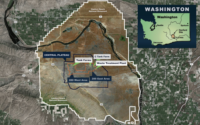 |
| Ashly Coggins |
In the first grade, I removed the letter “e” from my first name. What some might consider an act of rebellion, I believe was an early indication of taking charge once I realized there was a better way.
The year I was born, Ashley was the most popular name in the U.S. The process of having to write both my first and last name to avoid being confused with other Ashleys was inefficient. Omitting the useless vowel was the perfect solution. My parents and teachers were less enthusiastic. It took years of perseverance, but I eventually won them over.
As it turns out, acting to improve processes, building consensus and having the tenacity to see things through are skills that have defined much of my career.
One example is Safety Pin, a comprehensive safety planning application that monitors craft density, aids in emergency evacuations, improves communication among construction crews and supports life critical activity planning. The name is a nod to the program’s ability to pinpoint worker location much like dropping a pin in GPS applications.
After developing the idea with colleagues, I pitched Safety Pin to Fluor’s leadership, who quickly approved funding to develop and pilot the idea.
Moving an idea through a company of 60,000 employees from concept to implementation in less than a year, as we did with Safety Pin, is an incredible accomplishment. Along the way, I have discovered five strategies that help overcome challenges and turn concepts into reality.
1. Develop your elevator speech.
When I began pitching Safety Pin, it was just a concept. My efforts to describe it centered around, “you know…an RFID tracker or something similar, with forms and tablets.” With each blank stare, I reached for new words to convey the idea.
Eventually, the pitch evolved to, “I have an idea for a comprehensive safety planning application. By combining ID badges containing location sensors, electronic forms for pre-task planning and mobile devices, we could potentially reduce our incidents by 50%.” The blank stares began to disappear.
2. Stop, collaborate and listen.
While developing the Safety Pin concept, I started reviewing the idea with the main users – the health, safety and environmental (HSE) professionals, superintendents and foremen. Their input elevated my original concept considerably. I originally focused only on timesheets and permits. After brainstorming with superintendents, it was clear that Safety Pin had to start with the beginning of safety planning – pre-task planning forms. An HSE manager shared with me that tracking training histories was one of his biggest frustrations. His feedback shaped how we reconcile information between forms to improve assurance that safety protocols are followed on project sites.
When I found that I wasn’t gaining traction with the main users, instead of defending my points, I asked them what they would like to see changed and what would make their jobs easier. I worked with them to adjust my ideas and gain consensus.
3. Put your plan on paper.
After brainstorming with stakeholders, I put my plan on paper. I developed a baseline to hold myself accountable, with a bulleted list of objectives and data for the business case. I also defined a point where I would stop if certain objectives weren’t met.
4. Find sponsors for your idea.
Change is rarely done alone. Sponsors from all levels within the company are an essential component of success. Executives communicate the message through the organization, prioritize it among the company’s goals and connect you with key stakeholders. Mid-career individuals provide valuable, experience-based feedback on potential risks and opportunities. Individuals earlier in their career provide energy and new ideas.
I recall one initiative where success depended on superintendents adopting tablets in the field. Most superintendents saw the tablets as extra work and never used them. But one superintendent did. He became an interface for me with the other superintendents. He applied peer pressure and brought the other superintendents on board. Before long, they were trading tips and teaching me new things.
5. When all seems lost, take stock of what is working.
Often, when things felt they were stagnating, I had to revisit my plan and ask myself, “What is going well?” In one instance, I got stuck trying to convince others to use a tool, which had been successfully implemented on a previous project. I had lost sight of the end goal, which was enabling downstream tools for my team in the field. Revisiting the plan, I realized I could still support my team, without the buy-in of the reluctant team, with one small adjustment to the plan.
Ironically, I've yet to run into another Ashley on a construction site. Nonetheless, applying these approaches throughout my life has led to my most gratifying effort. Today, after months of collaboration, planning and development, Safety Pin is helping to enhance safety for our craft workers on a major construction site.
A construction area manager for Fluor Corp., Ashly Coggins also is piloting company use of the Safety Pin comprehensive safety planning tool that she invented. Since joining the contractor in 2008, she has applied innovative approaches in safety, construction planning and construction-based augmented reality applications. Ashly can be reached at ashly.coggins@fluor.com




Post a comment to this article
Report Abusive Comment